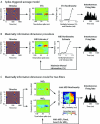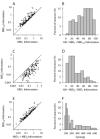Cooperative nonlinearities in auditory cortical neurons
- PMID: 18579084
- PMCID: PMC2535914
- DOI: 10.1016/j.neuron.2008.04.026
Cooperative nonlinearities in auditory cortical neurons
Abstract
Cortical receptive fields represent the signal preferences of sensory neurons. Receptive fields are thought to provide a representation of sensory experience from which the cerebral cortex may make interpretations. While it is essential to determine a neuron's receptive field, it remains unclear which features of the acoustic environment are specifically represented by neurons in the primary auditory cortex (AI). We characterized cat AI spectrotemporal receptive fields (STRFs) by finding both the spike-triggered average (STA) and stimulus dimensions that maximized the mutual information between response and stimulus. We derived a nonlinearity relating spiking to stimulus projection onto two maximally informative dimensions (MIDs). The STA was highly correlated with the first MID. Generally, the nonlinearity for the first MID was asymmetric and often monotonic in shape, while the second MID nonlinearity was symmetric and nonmonotonic. The joint nonlinearity for both MIDs revealed that most first and second MIDs were synergistic and thus should be considered conjointly. The difference between the nonlinearities suggests different possible roles for the MIDs in auditory processing.
Figures








Comment in
-
Characterizing auditory receptive fields.Neuron. 2008 Jun 26;58(6):829-31. doi: 10.1016/j.neuron.2008.06.004. Neuron. 2008. PMID: 18579074 Free PMC article. Review.
Similar articles
-
Hierarchical computation in the canonical auditory cortical circuit.Proc Natl Acad Sci U S A. 2009 Dec 22;106(51):21894-9. doi: 10.1073/pnas.0908383106. Epub 2009 Nov 16. Proc Natl Acad Sci U S A. 2009. PMID: 19918079 Free PMC article.
-
Functional congruity in local auditory cortical microcircuits.Neuroscience. 2016 Mar 1;316:402-19. doi: 10.1016/j.neuroscience.2015.12.057. Epub 2016 Jan 5. Neuroscience. 2016. PMID: 26768399 Free PMC article.
-
Distinct Manifestations of Cooperative, Multidimensional Stimulus Representations in Different Auditory Forebrain Stations.Cereb Cortex. 2020 May 14;30(5):3130-3147. doi: 10.1093/cercor/bhz299. Cereb Cortex. 2020. PMID: 32047882 Free PMC article.
-
Representations in auditory cortex.Curr Opin Neurobiol. 2009 Aug;19(4):430-3. doi: 10.1016/j.conb.2009.07.009. Epub 2009 Aug 10. Curr Opin Neurobiol. 2009. PMID: 19674890 Free PMC article. Review.
-
Distributed coding of sound locations in the auditory cortex.Biol Cybern. 2003 Nov;89(5):341-9. doi: 10.1007/s00422-003-0439-1. Epub 2003 Nov 12. Biol Cybern. 2003. PMID: 14669014 Review.
Cited by
-
Identifying functional bases for multidimensional neural computations.Neural Comput. 2013 Jul;25(7):1870-90. doi: 10.1162/NECO_a_00465. Epub 2013 Apr 22. Neural Comput. 2013. PMID: 23607565 Free PMC article.
-
Input-Specific Gain Modulation by Local Sensory Context Shapes Cortical and Thalamic Responses to Complex Sounds.Neuron. 2016 Jul 20;91(2):467-81. doi: 10.1016/j.neuron.2016.05.041. Epub 2016 Jun 23. Neuron. 2016. PMID: 27346532 Free PMC article.
-
Cortical oscillations and speech processing: emerging computational principles and operations.Nat Neurosci. 2012 Mar 18;15(4):511-7. doi: 10.1038/nn.3063. Nat Neurosci. 2012. PMID: 22426255 Free PMC article.
-
Plasticity of Multidimensional Receptive Fields in Core Rat Auditory Cortex Directed by Sound Statistics.Neuroscience. 2021 Jul 15;467:150-170. doi: 10.1016/j.neuroscience.2021.04.028. Epub 2021 May 2. Neuroscience. 2021. PMID: 33951506 Free PMC article.
-
Inferring the role of inhibition in auditory processing of complex natural stimuli.J Neurophysiol. 2012 Jun;107(12):3296-307. doi: 10.1152/jn.01173.2011. Epub 2012 Mar 28. J Neurophysiol. 2012. PMID: 22457454 Free PMC article.
References
-
- Adelman TL, Bialek W, Olberg RM. The information content of receptive fields. Neuron. 2003;40:823–833. - PubMed
-
- Adelson EH, Bergen JR. Spatiotemporal energy models for the perception of motion. J Opt Soc Am A. 1985;2:284–299. - PubMed
-
- Aertsen A, Johannesma PI. Spectro-temporal receptive fields of auditory neurons in the grassfrog. I. Characterization of tonal and natural stimuli. Biol Cybern. 1980;38:223–234. - PubMed
-
- Aguera y, Arcas B, Fairhall AL, Bialek W. Computation in a single neuron: Hodgkin and Huxley revisited. Neural Comput. 2003;15:1715–1749. - PubMed
-
- Bain LJ, Engelhardt M. Introduction to Probability and Mathematical Statistics. Second Edition PWS-KENT; Boston: 1992.
Publication types
MeSH terms
Grants and funding
LinkOut - more resources
Full Text Sources
Miscellaneous

